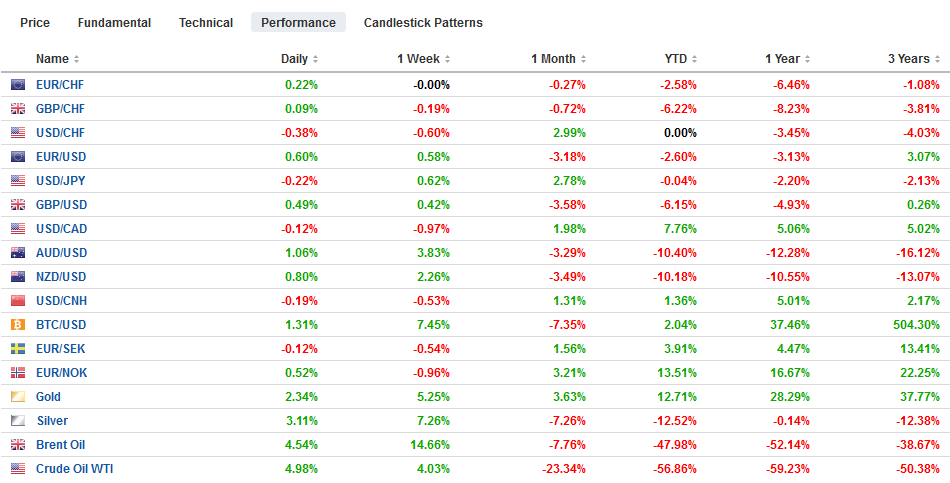Swiss FrancThe Euro has risen by 0.27% to 1.0577 |
EUR/CHF and USD/CHF, April 9(see more posts on EUR/CHF, USD/CHF, ) Source: markets.ft.com - Click to enlarge |
FX RatesOverview: Three deals need to be struck. First, the Eurogroup of finance ministers needs to reach an agreement of proposals for joint action to the heads of state. Second, oil producers need to cut output if prices are to stabilize. Third, the US Congress needs to strike a deal to provide more funding. Investor seems hopeful, and risk appetites are have lifted equities. Markets in the Asia Pacific region outside of Japan and Taiwan rose, led by 3%+ gains in Australia and India. Europe’s Dow Jones Stoxx 600 is pushing higher and has now met a (38.2%) retracement of this year’s decline, while US shares are firmer, and the S&P 500 is closing in on a 50% retracement (~2793). Core bond yields are a little lower, with the US 10-year yield off three basis points to 0.74%. Peripheral bond yields are firmer, with Italy’s benchmark yield rising six basis points. The dollar is mixed. The Scandis are leading the European currencies higher, while the dollar bloc and yen as nursing small losses. Gold is straddling the $1650 level while oil is firm but continues to consolidate pending new developments. Russia appears to have signaled that it could reduce its output by 1.6 mln barrels a day (~15%). |
FX Performance, April 9 |
Asia Pacific
Singapore reported an infection spike. The re-opening of Wuhan that celebrated yesterday is looking more complicated as some restrictions have been tightened amid new flare-ups. In Tokyo, confusion undermined the efforts to impose a lockdown after Economic Minister Nishimura, who heads the government’s response to the pandemic, asked governors to hold off decisions to shutter businesses until after the Abe government assessed the impact of individual requests for individuals to stay home. The state of emergency was to shut down about half the economy.
The Bank of Japan cut the outlook of all Japan’s regions. The BOJ will meet later this month and update its forecasts. In his speech to the regional branches, Governor Kuroda did not discuss inflation, and this omission was seen as a signal that the official inflation forecast will be cut. In turn, this is a prerequisite to embolden the BOJ further to address the economic crisis. The preliminary estimate of a nearly 41% drop in March machine orders underscores expectations that the world’s third-largest economy, which contracted in Q4, is contracting at a double-digit pace.
Foreign investors have been aggressive sellers of Japanese assets in recent weeks but turned buyers last week. A seven-week divest campaign sold foreign investors sell JPY5 trillion (~$46 bln) of Japanese equities before buying about JPY423 bln last week. Foreign investors sold JPY6 trillion of Japanese bonds in the last full two weeks of Japan’s fiscal year but bought back almost JPY500 bln last week. Meanwhile, Japanese investors sold JPY1.06 trillion of foreign bonds last week. There appears to be a bit of a seasonal pattern here as Japanese investors are often significant sellers of foreign bonds at the start of the new fiscal year.
The dollar is confined to about a quarter of a yen range thus far today (~JPY108.80-JPY109.05). There is a nearly $960 mln option at JPY109 that will be cut today. The dollar finished last week near JPY108.50. It has traded in about a one yen range this week (~JPY108.30-JPY109.30). The Australian dollar pushed above $0.6200 yesterday and reached $0.6250 today. The $0.6270 area corresponds to the 50% retracement of this year’s slump. After falling in the last four sessions of last week, the Aussie has advanced in the four sessions of this week. The dollar remains in the lower end of its range against the Chinese yuan, holding above CNY7.05 for the second day.
Europe
Italy, which reports said yesterday, was considering how to unwind the national shutdown, has seen a rise in infections, and is now looking to extend the restrictions. Germany saw the largest increase in new cases in five days. Sweden, which is trying a different course to combat the infections, is being watched closely, though cases are still rising quickly.
The UK has taken a significant step today: The government announced it would boost the size of its bank account with the Bank of England. It is known as the “Ways and Means Facility” and usually is around GBP370 mln. It did not specify a new limit, and it effectively allows the government to spend more money in the short-term without having to issue more debt. During the Great Financial Crisis, the facility rose to about GBP20 bln. Economists call this “direct financing of the government.” The Treasury insisted that the measures will be temporary and short-term, and assured that any overdraft would be repaid as soon as possible before the end of the year. Some observers are concerned that is may become permanent. Below the surface, there is likely tension with the Bank of England, as the new Governor (Bailey) seemed to rule out the use of the facility a couple of weeks ago.
ECB President Lagarde as taken to the op-ed pages to press the European governments into a strong and coordinated fiscal response. She is a clear advocate for the mutualization of costs to combat the virus and cushion economies. As Finance Minister for France during the Great Financial Crisis, Lagarde was vocal then too, as France was, for the creditor nations to bear greater costs to support the euro area. The lack of a stronger response then has led to an under-performance of the eurozone over the past decade. The risk is a repeat of this pattern with ominous implications for the future and for the political climate in Europe going forward. Former ECB President Trichet said that the North-South (creditor-debtor) in Europe is counterproductive. It is, but it does not change the fact that the divide exists and defines, to no small measure, how EMU members define the problem and solutions.
The euro is in less than half a cent range (~$1.0840-$1.0885). Participants used to find such narrow ranges as boring, but after the neck-breaking and stomach-wrenching volatility, the quieter tone is welcome. The euro is consolidating inside yesterday’s range. It settled last week near $1.08. Sterling is firm. It has risen above the previous session’s high for the third day running. The key hurdle on the upside is $1.25, which has frustrated gains for the last two weeks. With thinning volumes ahead of a long holiday weekend, the cap may remain intact.
America
Shortly after the US reports another surge in weekly jobless claims, Fed Chief Powell will give an economic update via webcast (10:00 am ET). It’s not what the Fed is doing, but what else it may do that is of main interest. In particular, there are two main areas of interest outside of the Chairman’s economic assessment. The first is that the average effective Fed funds rate is has been trading at five basis points in recent days. In the corridor system, the interest on reserves should be the floor, but that is at 10 bp. The Fed could raise in interest on reserves, and it is reverse repo operations, which how it defends lower bound.
The second issue is about the transmission mechanism of monetary policy, and another option in the playbook is what Japan introduced as yield curve control, and Australia adopted a similar strategy. BOJ targets the 10-year bond yield, and the RBA targets the three-year bond yield. A timely paper by Kenneth Garbade of the NY Fed reviewing the Fed efforts in this back in the 1940s and concludes that the central bank would need to take into account the volatility of interest rates and debt management policies. The latter may be particularly difficult given the explosion of US supply in the period ahead. Garbade also warns that large scale open market operations may be necessary to adjust the shape of the yield curve on occasion.
Separately, the US payroll protection program has been so successfully launched that it needs more funding. The Senate is planning on a vote today for another $250 bln. The Democrats are looking to double the size by adding $100 bln for hospitals and $150 bln for state and local governments.
Canada publishes its March employment report today. The jobless claims warn of a dramatic loss of jobs, but like we saw in the US, the national figures are not calculated the same way, and discrepancies are likely. Still, the median forecast in the Bloomberg survey calls for a loss of 500k jobs (remember the Canadian economy is roughly 1/10 the size of the US). The median expects the unemployment rate to rise to 7.5% from 5.6%. Meanwhile, Canada is adjusting the aid efforts by allowing news businesses to participate and lower the threshold of losses needed to qualify.
The US dollar is trading broadly sideways against the Canadian dollar. It has been confined to about a 50-point range above CAD1.40. For the second consecutive session, it is making a lower high and a higher low. Beyond yesterday’s high (~CAD1.4080), an expiring option for $1 bln is struck at CAD1.41. The CAD1.3925-CAD1.3945 offers support below CAD1.40. After setting a record high on Monday against the Mexican peso, the greenback has eased, and around MXN23.80 now is at five-day lows. It is slipping below the 20-day moving average (~MXN23.90) for the first time since late February. The next support area is seen near MXN23.50.
Graphs and additional information on Swiss Franc by the snbchf team.
Full story here Are you the author? Previous post See more for Next postTags: #USD,Bank of England,Canada,ECB,EUR/CHF,Europe,federal-reserve,newsletter,OIL,U.K.,USD/CHF





























